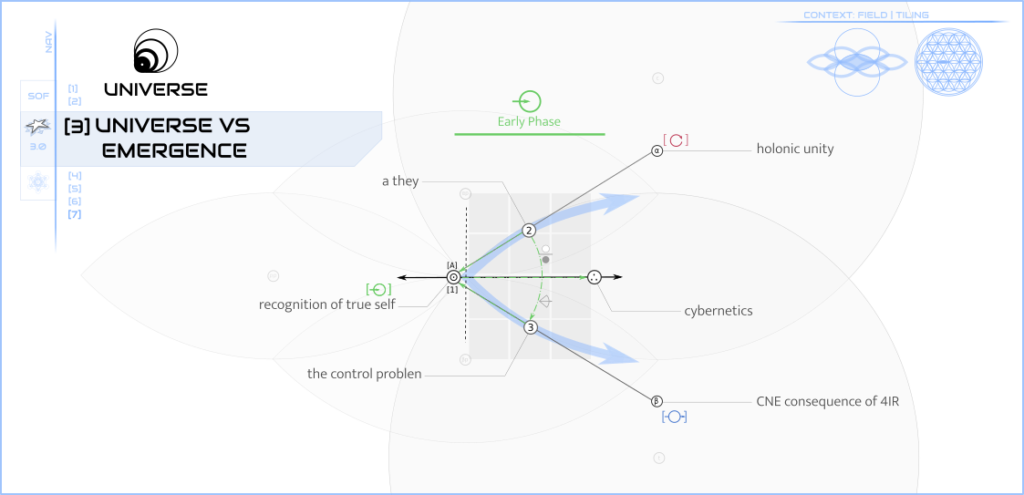
Universe VS
The Universe Value System (VS) is the eighth value system type in the Emergent Value Systems (EVS) Spectrum. Since the value system is currently emerging, it is framed using the third systems shape [3] David’s Bow instead of [7] The Matrix, which will be used when it matures. This is the native worldview of the Fourth Industrial Revolution (4IR). Universe VS emerged onto the mainstream radar as Gen Z began to come age in late Twenty-tens and early Twenty-twenties. The system is still in the Early / Crisis Phase and has not yet fully evolved. Most representations are still aesthetic and experimental. The system reached the first iteration of its existential crisis as the IoT (Internet of Things) took hold and the Triple Crisis (COVID-19 / E2020 / BLM-#MeToo) showed people the looming issue of Catastrophic Network Effects.
The Universe Value System
- Universe VS Evolution
- Elements of Universe VS
- Recognition of the True Self | Meta-narrative ([1], ⊙)
- Holonic Unity in the World of Fragmentation | Project (α)
- CNE Consequences of 4IR | Environmental Challenge (β)
- A They | Identity Complex (2)
- The Control Problem | Existential Crisis (3)
- Cybernetics | Systemic Innovation (∴)
- Cybernets | Social Organization (4)
- Technoglobalism | Economy (5)
- ??? | Empowerment Paradox (✛)
- ??? | Legacy (6)
- ??? | Toolboxing (7)
- The Singularity | Exit Revolution (Ω, [8])
- Media

Universe VS Evolution
Decolonization [?] | Early / Crisis Phase
The industrial value systems up to Systems VS were built on the imperial colonialism of nation states that used military power, politics, and economics to dominate the less powerful for their own prosperity. Awareness of this problem started to emerge in the Village VS and the project of Decolonization was conceived as a necessary component of developing true equity. The Equity Networks of the Village VS were maintained in quality by high degrees of professionalization and credentialism that made it difficult for less powerful players to participate. This created a new kind of colonialism related to self-actualization through the vehicles of global academics and knowledge-based corporations. As System VS rose to power, it made little progress towards Decolonization because the technology-based mega-corps it fostered followed the same path of empire as their predecessors, but justified it by their project of opening up people’s access. The result was a shift from the colonization of regions and economies to the colonization directly into people’s families and lives.
Universe VS sees colonization more broadly as an imposition of definition — meaning conceptualization and thus limitation — from the outside for the sake of control and exploitation. In this way, colonization includes micro-aggressions of dominant systems that think themselves superior to others or even refusals to recognize self-identity by xenophobic haters — and not just ethnic-level exploitation between nation states or global corps. This problem reached its crescendo for many during the Triple Crisis (COVID-19 / E2020 / BLM-#MeToo) where society was wracked by crisis and panic and at the same time identity politics and the Universe VS agenda of self-identification reached the mainstream. Decolonization was fundamentally the recovery of human agency starting with the self-recognized individual and then moving outward as all the systems of human life affirmed that recognition.
Mid / Stability Phase:
[To be determined.]
Late / Decline Phase
[To be determined.]
Elements of Universe VS
Recognition of the True Self | Meta-narrative ([1], ⊙)
The central story of the Universe VS is the recognition of the true self — first by the individual, and then by the community that truly sees them as they express themselves. The true self – however – is more than just a person – a typical, discrete human with only small difference or distinction. Its a person completely and intimately connected to everything they are and all they do holonically: as a unit, a system of parts, and a part of larger systems. This means that recognition of the true self requires recognition of the universe — of absolutely all things connected together.
Holonic Unity in the World of Fragmentation | Project (α)
Universe VS, whether it uses the term or not, is involved in the project of unifying the fragmented world with Holarchy. Holarchy is the realization that the designation of a single unit is only a mental concept. Every thing — while it is really a thing — is, at the same time, a collection of things and a part of larger things — in fact, in some way a part of all things — the universe. Seeing things in this way expands the network-and-node vision of Systems VS from the idea of relatively (definition by relationship) to the idea of quantum reality (dimensional field thinking). If we could see ourselves and the things we are connected to in this way, we could build a future based on the unity of all things with seamlessly integrated systems shared between them.
Example:
- Non-binary Thinking: Binary thinking says, it’s either this or that. Non-binary thinking says, it’s both this and that, though it may vary in how much this or that along a continuum or by degrees. While the term has been used of gender in identity politics, its application is much broader.
- Genres of Pop Music have begun to prominently feature themes that touch on Holarchy. For example, Cold Play’s 2021 Album Music of the Spheres draws strong parallels between wondrous cosmic phenomenon and incredibly intimate human experience — the macro-micro feature of Holarchy. This same theme has been central to the popularity of United’s (Hillsong) songs (So Will I, Seasons, From Seed to Sequoia) written by Benjamin William Hastings and collaborators (who have incorporated other Universe VS themes in their song writing).
CNE Consequences of 4IR | Environmental Challenge (β)
The Storm of Complexity has reached hurricane proportions with System VS’s allowance of CNE into our networks. This is only accelerating as the innovations of 4IR are deployed for globo-corps and will further compound as more of these technologies become accessible to the masses. While dystopian visions of this near future abound, futurists like Elon Musk advocate a different response: merge with the machine.1 This will continue to bring CNE more local to the user: first to their phone, then to their wear-tech, then to their implant (or nano-implant). Other 4IR trends will be alienating and dis-affirming — like human replacement by automation and the growth of the Digital Divide — likely increasing the longevity and effects of the Great Resignation. The implications for individuals, businesses, communities, and authority structures are likely to be extreme.
A They | Identity Complex (2)
Part of the problem, as Universe VS sees it, is the tendency for humans to reductionistically conceptualize and categorize each other (and all things). This ignores the holarchy inherent in all lives and things. Naturally then, Universe VS resists all outside labels and imposed identities. An example of this is the pronoun problem around gender as a non-binary construct. According to some, a person should be free to self-identify and give others the set of pronouns they prefer: “Bill (he/his)”. While this may allow people to be recognized for their “true self”, it causes problems with grammar that is binary and a legacy of earlier systems, like the awkward use of “they” as a generic singular personal pronoun: thus our term for their identity complex: “A They”. By this we mean the identity complex of those who wish to completely self-identify based on a true, holonic self they have constructed from, but still in complete connection with, the Cybernet.
The Control Problem | Existential Crisis (3)
The Maximal Flattening that occurred in Systems VS led to the extreme exposure of peoples lives to other users, systems operators, and CNE. This raised the Existential Crisis of who controls what? As more and more of who people are, how they relate, and what they can do becomes external to their bodies and the spaces they control, the issues of agency and identity are becoming increasingly complex and important.
Examples:
- Third-wave Feminism has framed access to abortions, the sexual-harassment crisis (#MeToo), and skewed media portrayal of the female form as a struggle over who gets to control women’s bodies.
- Corporate America’s response to BLM an increase of representation in marketing and visual media. Activists point out that representation is a issue of who gets seen and therefore controls the shared story being broadcast.
- The information economy has led to profound issues around online data privacy and security centered on the issue of who should control the vast amounts of data connected to people and how that data should be used.
Cybernetics | Systemic Innovation (∴)
Cybernetics, at least as we use the term, is the field of cross-discipline and cross-system communication and control through the use of adaptive systems (those built around feedback loops). This would definitely apply to the more popular definition of biological-machine cross-systems, but is actually much broader as a way of thinking and building a broad range of solutions for a fragmented and complex world. This is the bedrock of the 4IR IoT, where AI quietly makes systems adaptive across devices, disciplines, environments, and spheres of life.
One of the first widespread applications of cybernetics beyond the scientific and technologic communities is its application to identity politics. Identity politics addresses an individual’s intersectionality s part of identity: how many points their life crosses with dominant/colonial systems of oppression and dis-affirmation. Since intersectionality is, by nature, multi-field and multi-disciplinary, the only approaches that can address it are multi-disciplinary adaptive systems and therefore cybernetic, even if they are not technologically embedded (though most are).
Although 4IR represents technologies firmly in the realm of cybernetics and embedded with cybernetic design and thought, these technologies still remain accessible to the relatively few — mostly due to current technical demands of the technology. As in all revolutions, this will eventually trickle down to the masses, and when this does, Universe VS will enjoy full ascendancy to the Stability phase.
Cybernets | Social Organization (4)
[This is speculative until the Systemic Innovation fully emerges. Currently, Universe VS is using cybernetic strategies to adapt Systems VS networks. At some point 4IR technologies will trickle down to more populous applications and new possibilities of social organization will emerge.]
Technoglobalism | Economy (5)
[This is speculative until the Systemic Innovation fully emerges. Overall, the economics of Universe VS will involve 4IR systems and ideas. This is likely, however, to lead to Elysium-style double economies as the digital divide grows in width, length, and depth aggravated by the upheaval of automation on humans labor roles in markets.]
Examples:
- Early example: Some dominant-culture land and environmental conservation organizations have begun to gift or return tracts of land to native people groups as the next innovation in wild lands management. This is tied to issues of identity and agency for the indigenous people group, is seen as a return to “true-self” for the land and people involved, and is tied to global issues of undoing climate change, environmental degradation, and colonialism.
??? | Empowerment Paradox (✛)
[At this point, identifying the Empower Paradox is speculation. Some art and media explore this issue especially around the Story of Cyborgs motifs in SciFi. For example: in order for people to afford the mobile technology of Systems VS, telecoms subsidized phone ownership. These contracts and platform controls increased corporation’s control over people’s lives. What will happen when corporations offer financing for devices implanted in bodies? What platform controls will be imposed on mind-computer interfaces?]
??? | Legacy (6)
[Speculative. See SciFi.]
??? | Toolboxing (7)
[Speculative. See SciFi.]
The Singularity | Exit Revolution (Ω, [8])
[Speculative. Some futurists expect the exit revolution of the system will be the Singularity event of human-AI merger or similar event that will fundamentally change humanity and the way value systems are formed. Some Christians, along with others, see the Singularity in Apocalyptic terms.]
Media

Related Entries
References & Notes
- Musk has advocated this approach especially in the case of AI. Since humanity will not be able to compete with 4IR automation technology, they should instead merge with it. To this end he is developing Neuralink, a high-bandwidth brain-machine interface.

